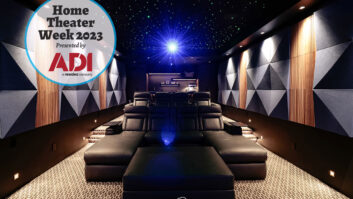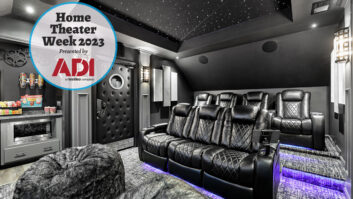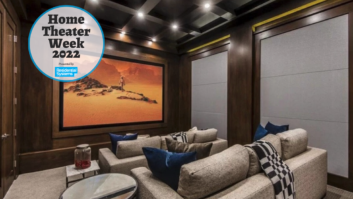You have designed, installed, debugged, and verified proper function of all components of a full-blown high-end multichannel audio system, and you are ready to get to the next phase: calibration.
Finally! Level calibration,” you say. This is where most folks start, but you would have spent a good number of hours with all the system tests and verification work to avoid having to face any unusual surprises. Believe me, all that preparation work will save you time in the long run. The good part is that this is where the real fun begins.
The premise of level calibration is simple. Each channel should produce the same predetermined sound level given the same electrical level in the internal guts of the surround processor. Each speaker in the room will have its own sensitivity, and its placement in the room will further affect that. This step of the process is to compensate for those speaker and room location differences. Most of you already know how to set levels in the surround processor, and here are a few additional guidelines.
You are going to generate test signals into the speakers and set the output level controls of each channels so that they all match each other and come up at a specific level. If you are working with a THX-certified surround processor, simply use the internal test tone. It is precisely calibrated to give you a match of sound level relative to what is heard in the film studio where soundtracks are produced.
To get to this test mode, find your way to the set-up menu. Then, after completing the speaker system configuration, time synchronization settings and a few other configuration steps, you should find a menu called “Speaker Levels,” or “Channel Levels,” or any similar name. Usually, once you’re in that menu you will hear a test noise coming from the left speaker first. On some processors you have to turn on the test noise or select “Internal Test” before proceeding. However you get there, once you hear that famous test noise coming from the speakers find the control for “level up/down.” Then adjust it so that the sound level at the seating position is 75dB SPL, in Flat or C Weighting, Slow mode, for each speaker in turn. Make sure to use the channel-level control, not the master volume control, for this setting (although on a few processors the volume-control keys are used for setting the channel levels when in the calibration mode.) You should use a sound level meter to accurately measure this sound pressure level.
Sound level meters come in all shapes, sizes and prices. It turns out that the little Radio Shack 33-2050 analog meter (one of the cheapest of the bunch) works really well for mid-frequency sounds. The internal test tones of THX-certified processors are intentionally limited to mid-frequencies from 500 Hz to 2 kHz for the main channel adjustments. This reduces the effects of room variances at low frequencies and reduces high frequency errors from speaker and microphone directivity limitations. Besides, our ears are more sensitive to mid-frequency level matching, so you might as well emphasize those for best adjustment accuracy. At those mid-frequencies the Radio Shack meter is accurate to about a 2 dB variation from a reference multi-thousand dollar “He-Man” SPL meter.
To best use the level meter, hold it at arm’s length over the main seat position, with the microphone at seated ear height. You can also verify level variations at the other seats in the theater and adjust the channel gain for an average, if that better suits the theater’s use.
Calibrate the left level, then the center, and go on all around the room from there, until all of the available speaker channels have been tuned. Try to get within 0.5 dB for better systems.
A note about setting surround levels: Because surround speakers can be pretty close to some of the seats in the listening area, changes in measurement locations can result in level changes of several dB. So, where you set the levels depends on the room’s use. If there is to be one sweet spot, with other listeners putting up with sub-par conditions, the answer is simple: Make it just right at the one seat that counts. For a room in which you want many seats to have a reasonable soundfield balance, things can get trickier. You might need to set levels for an average between the seats. If you notice level variations in excess of 3 dB between seats, you might want to reconsider the surround speaker locations, types and numbers. Sometimes doubling up on surround speakers can give you a uniform soundfield balance with hardly any level variations from side to side. In a room with four rows, I would definitely use two pairs of side surrounds. You can set the level of the back seat a little quieter to balance the level falloff from the front speakers. To determine how much attenuation the rear set needs, simply play mid-frequency test noise in the front-center speaker, measure the difference in level between the front and rear rows of seats, and now you know what the level difference needs to be in the two pairs. To set levels differently you will either need a surround processor with enough assignable and controllable outputs, or a separate power amp for the rear pair. These would enable you to have level controls to set for the front/rear row difference that you are targeting. Remember to verify all the measurements and math with your ears; the test tones should end up sounding the same all around the systems’ speakers no matter where you sit in the room.
As you go around the room and get done calibrating levels on all the main speakers, you will end up at the subwoofer. The test signal will change radically. The mid-frequency sounds obviously are not suitable for the bass driver. Surround processors switch their test signal for bass. It becomes a test noise typically from 40 Hz to 80 Hz, but with an average voltage level matching that of the main speakers’ test signal. It will sound like a dull rumble and your job it to simply adjust the subwoofer channel level until you read 75 dB SPL on your meter. If you are way down in level when the test signal starts check the following: Subwoofer power is on? Meter is in Flat or C weighting? (“A” weighting will cut down bass levels). The level control on the subwoofer is up? Have you enabled the subwoofer output in the surround processor’s configuration menu?
Because of the room-dependant nature of bass sounds you should move the meter around the listening area to get an averaged value. Also, you will notice the needle bouncing around quite a bit. Look for the average reading in the middle of the bounce zone.
When using the Radio Shack meter for low-frequency tests, you find yourself asking why a cheap meter housed in a plastic box can be as accurate as a really expensive one. The answer is that it isn’t completely accurate at all frequencies. In the mid-band it’s okay, but at low frequencies it goes out of spec. In fact it can be as much as 4 dB off when using it for setting the subwoofer levels. So if you want to get more accurate results you may want to consider a better meter, such as the Gold Line SPL120, the CEL231, the Velleman DVM1351, or the SPL portion of the Gold Line DSP30 analyzer.
Once you have gone through setting the levels of all the outputs ask yourself if it all matches what your ears are telling you. Does the test signal sound like it is producing the same level at the main speakers? Cycle the test signal quickly around the speakers, and check it out. You might find that the surrounds don’t quite match what the level meter said was right. This can be due to your ear’s directionality, the room acoustics, the types of speakers and a whole host of other factors. I would recommend tweaking it up or down until the sound level actually does sound the same out of all the speakers. The main reason for you to use the sound level meter is to get you in the middle of the “ballpark” and at the right absolute level for the three front speakers. In the end, however, trust your ears as much as the test gear.
If you are working with a surround processor that is not THX-certified you may or may not end up with correctly set test tones. In these cases, you can still use the internal test signal, but you can’t be sure of its accuracy in either absolute or inter-channel relative levels. I recommend using a good test disk as verification. The ones I would trust are the AVIA DVD and the 5.1 Audio Toolkit DVD. Both have carefully setup test levels and offer mid-frequency test noise as well as wideband pink noise. Remember to always use mid-frequency, band-limited pink noise for level calibration, or else you might be off by several dB due to speaker/room/microphone variability.
Note that the test disk levels might be off from the surround processor levels by 4 dB. This is due to a process called Dialog Normalization (a.k.a. DialNorm) in the Dolby Digital bitstream. It allows the program producer to preset the volume control to provide a match of dialog level across several productions with varying peak level. On average, films on DVD are set for DialNorm 27, which attenuates the volume control by 4 dB. If the test disk is produced at DialNorm 27 to match most movies, its test tones might be 4 dB down from the internal ones of the surround processor. This was a matter of ongoing debate between Dolby, THX and product manufacturers, but is now pretty much cleared up. Most recent products hitting the market have internal test tones that would match those of a test disk at DialNorm 27. If you do have one of the mismatched ones, I’d recommend matching the film levels. Meaning that you should trust the disk test tones.
For setting the subwoofer, make sure to use a signal called “LFE level,” and make sure it is designed to play at a preset level (either 75 dB or 85 dB SPL.) If you find it is way down after setting the subwoofer gain from the surround processor internal signals and after attempting to verify it with a test disk, you might have run into an error in the LFE gain setting. The 5.1 channel formats call for LFE to be recorded 10 dB, low in the track, and then boosted by 10 dB during playback. This yields higher headroom in bass sound levels without noticeable increase of noise level, because our ears are relatively insensitive to low-frequency background noise.
The test DVD LFE test signal is set up to generate the desired 75 dB SPL from an electrical level 10 dB below those of the other channels. That way you will be running the LFE channel gain 10 dB hot. Usually you don’t need to do anything to get there because the internal circuits of the processor will be factory set for that 10-dB boost. On some products the LFE signal gain is actually adjustable, and it might be on the wrong setting by the time you get to calibrate the system. You’re the one that has to find it and fix it.
Sometimes these controls are located in the set-up menu, and sometimes they are buried deep in a PC-controlled configuration interface. It is your mission to track down and adjust the control if the levels don’t match between bass from a low-frequency reference test signal in a main channel and bass from a reference signal in LFE, 10dB down from the main channel. With the 5.1 Audio toolkit, compare the levels in Chapter 78 (-10dBr center-channel bass test signal) and Chapter 7 (-20dBr LFE-channel bass test signal) of Title 1. Both should come up at 75 dB SPL. Remember to keep the SPL meter at a fixed location for these tests, as there can be wild variations in the room’s bass response.
I bet you never thought that there was this much involved in setting levels of a surround system. If it were simple, they wouldn’t need us custom folks.
Your next step will be to calibrate the system’s frequency response though speaker placement and electronic equalization compensation. We’ll have to talk about that another day, though. Until then, get those SPL meters dusted off, and remember to put fresh batteries in them.
Anthony Grimani is president of Performance Media Industries, an acoustical architecture firm specializing in home theater design and calibration.






